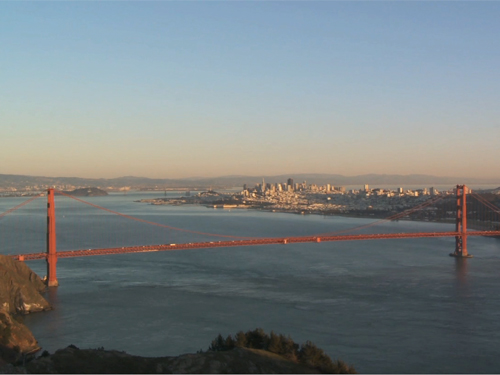SAN FRANCISCO proper occupies just 48 hilly square miles at the tip of a slender peninsula, almost perfectly centered along the California coast. Arguably the most beautiful, certainly the most liberal city in the US, it remains true to itself: a funky, individualistic, surprisingly small city whose people pride themselves on being the cultured counterparts to their cousins in LA – the last bastion of civilization on the lunatic fringe of America. It's a compact and approachable place, where downtown streets rise on impossible gradients to reveal stunning views of the city, the bay and beyond, and blanket fogs roll in unexpectedly to envelop the city in mist. This is not the California of mono-tonous blue skies and slothful warmth – the temperatures rarely exceed the seventies, and even during summer can drop much lower.
The original inhabitants of this area, the Ohlone Indians, were all but wiped out within a few years of the establishment in 1776 of the Mission Dolores, the sixth in the chain of Spanish Catholic missions that ran the length of California. Two years after the Americans replaced the Mexicans in 1846, the discovery of gold in the Sierra foothills precipitated the rip-roaring Gold Rush. Within a year fifty thousand pioneers had traveled west, and east from China, turning San Francisco from a muddy village and wasteland of sand dunes into a thriving supply center and transit town. By the time the transcontinental railroad was completed in 1869, San Francisco was a lawless, rowdy boomtown of bordellos and drinking dens, something the moneyed elite – who hit it big on the much more dependable silver Comstock Load – worked hard to mend, constructing wide boulevards, parks, a cable car system and elaborate Victorian redwood mansions.
In the midst of the city's golden age, however, a massive earthquake, followed by three days of fire, wiped out most of the town in 1906. Rebuilding began immediately, resulting in a city more magnificent than before; in the decades that followed, writers like Dashiell Hammett and Jack London lived and worked here. Many of the city's landmarks, including Coit Tower and both the Golden Gate and Bay bridges, were built in the 1920s and 1930s. By World War II San Francisco had been eclipsed by Los Angeles as the main west coast city, but it achieved a new cultural eminence with the emergence of the Beats in the Fifties and the hippies in the Sixties, when the fusion of music, protest, rebellion and, of course, drugs that characterized 1967's "Summer of Love" took over the Haight-Ashbury district.

In a conservative America, San Francisco's reputation as a liberal oasis continues to grow, attracting waves of resettlers from all over the US. It is estimated that over half the city's population originates from somewhere else. It is a city in a constant state of evolution, fast gentrifying itself into one of the most high-end towns on earth – thanks, in part, to the disposable incomes pumped into its coffers from its sizeable singles and gay contingents. Gay capital of the world, San Francisco has also been the scene of the dot.com revolution's rise and fall. The resultant wealth at one time made housing prices skyrocket – often at the expense of the city's middle and lower classes – but the closure of hundreds of start-up IT companies has brought real-estate prices back down to (almost) reasonable levels. Despite the city's current economic ebbs and flows, your impression of the city likely won't be altered – it remains one of the most proudly distinct places to be found anywhere.

















0 comments:
Post a Comment